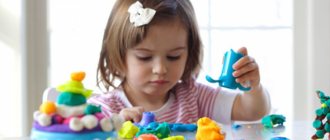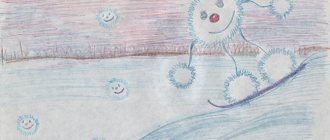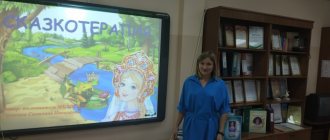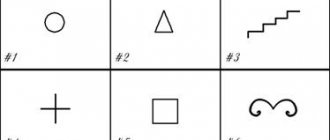Bottom line
As you can see, productive skills developed in preschool age have a lot of advantages:
- development of the pupil’s aesthetic and moral feelings;
- improving his mental and physical aspects;
- formation of concepts about space, form, composition;
- acquisition of additional skills in working with tools and office supplies;
- development of perseverance, hard work, logic.
And in order to achieve all this, you don’t need to do much: provide the baby with all the necessary materials and together with him try to make a craft, sculpt a figurine or draw a picture.
This will bring pleasure to both you and your child, and will help him take another step towards his successful education. leave a comment
Productive activity for preschoolers: drawing
Kids especially love to draw. Here they have scope for imagination, everything is depicted on paper: heroes of fairy tales, space, forests, individual objects, patterns, scenes experienced in life - here the child fully realizes his thinking. By drawing, children once again relive the emotions they have experienced and reveal their thoughts. Usually, a drawing task is given on independent topics, that is, everyone decides for themselves what, how and in what color to depict. From the drawings you can judge the baby’s character and find out his fears that he keeps to himself. Sometimes it is recommended to visit a psychologist so that he can solve the child’s problem and correct his understanding of the world around him.
Lesson results
It is necessary to create a system of activities for children. If the teacher correctly distributes productive activities, and all its types are involved, the result will be as follows:
- children will be developed creatively;
- the group will have an excellent psychological atmosphere;
- preschoolers will be well prepared for school classes.
Most often, productive activity connects several areas, such as creativity, socialization, cognition, labor, communication, and the safety of preschoolers. Artistic and productive activities and creativity help develop a child’s speech. At this age there are many problems with her, such as poverty (poor vocabulary), monosyllabicity, it consists only of simple sentences, and the words are far from beautiful and literary. For example: “what”, instead of “what”, “beautiful flower”, instead of “I like this flower because...”, but instead of “I don’t want this because...” you can hear “leave me alone”, and others expressions. Children need to be taught to speak beautifully and explain their preferences more fully and efficiently.
In addition, children receive moral education, consolidate the knowledge acquired in the learning process, and develop the necessary character qualities:
- activity;
- independence;
- observation;
- determination;
- patience;
- the desire to finish what you started;
- the ability to “sort out” the information received and assimilate it.
Productive activity also improves the physical condition of children. They become more cheerful, their mood improves, their overall tone increases, their character becomes more relaxed and active. After classes and during them, the child is active. It is important to immediately correctly form his posture, gait, and body position, because all these qualities will be useful to the little man in the future. Productive activity allows you to coordinate movements, “tune” the vestibular apparatus, and strengthen the muscles.
Now we propose to get acquainted with the main types of productive activities. And at the same time we will note the features of each.
Psychological characteristics of a preschool child
Preschool childhood is the period from the moment of awareness of oneself as a member of human society (from about 2-3 years) to the moment of systematic education (6-7 years). In this process, social factors in personality formation play a decisive role. In preschool childhood, the basic individual psychological characteristics of the child are formed, and conditions are created for the formation of social and moral characteristics of the individual.
This phase of childhood is characterized by:
- As a last resort, the child needs the help of an adult to meet the basic needs of life;
- the maximum possible role of the family in satisfying all basic needs (material, spiritual, cognitive);
- minimal possibility of self-protection from harmful environmental influences.
Appeal. By the age of six, a child’s vocabulary has expanded so much that he can easily explain to another person everything that relates to everyday life and his area of interest. While a typically developing three-year-old child uses up to 500 or more words, a six-year-old child uses between 3,000 and 7,000 words. A six-year-old child's vocabulary consists of nouns, verbs, pronouns, adjectives, numerals and connectives.
Sensory development. A child attending kindergarten not only distinguishes colors, shapes, sizes of objects and their position in space, but can also correctly name the proposed colors and shapes of objects and correctly distribute objects by size. He can also draw simple shapes and color them in a specific color. It is very important that the child can establish the identity of objects with a certain norm. Standards are humanity’s models of the main varieties of qualities and properties of objects. Thus, the standards of perception (sensory standards) are: colors of the spectrum, white and black colors, all kinds of shapes, sound levels, time intervals, etc. They arose during the history of human culture and are used by people as models, standards, with the help of which the compliance of perceived reality with one or another standard from a system of ordered standards is determined.
If a child can correctly name the color and shape of an object, if he can correlate the perceived quality with the norm, then we can assume that he can establish identity (the ball is round), partial similarity (the apple is round, but not perfectly similar to the ball), dissimilarity (the ball and cube). By carefully examining, touching or listening, the child performs correlative actions and traces the connection between what he perceives and the standard.
Development of thinking. A feature of a child’s healthy psyche is cognitive activity. A child’s curiosity is constantly aimed at understanding the world around him and forming his own picture of this world. The child plays, experiments, tries to establish cause-and-effect relationships and dependencies. For example, he himself can understand which objects will sink and which will float. He has many questions about the phenomena of life. The more intellectually active a child is, the more questions he asks and the more varied these questions become.
Development of attention. The child’s cognitive activity in exploring the world around him organizes his attention to the objects under study for quite a long time, until his interest wanes. If a six-year-old child is engaged in a game that is important to him, he can play for two or even three hours without being distracted. He can focus on productive activities (drawing, designing, work that is meaningful to him) for the same amount of time. However, such results of concentration are a consequence of interest in what the child is doing. He will languish, be distracted, and feel completely miserable when he has to engage in activities that are not suitable for him or that he does not like at all.
Memory development. Preschool age is an age of intensive memory development. It is generally accepted that memory is the leading cognitive process. In fact, a preschool child masters the language to such an extent that he becomes a true native speaker of his native language. Memory records and stores events and information that are significant to the child. Preschool childhood leaves many memories that will last a lifetime.
A six-year-old child can already voluntarily remember objects. When memorization becomes a condition for successful play or is important for the realization of a child’s aspirations, he easily remembers words in a certain order, poems, sequences of actions, and so on. A six-year-old child is already consciously able to use memorization techniques. He repeats what needs to be remembered, tries to understand, assimilate what was memorized in a certain order. However, involuntary memorization remains more productive. Here, too, everything is determined by the child’s interest in what he is doing.
Development of imagination. A six-year-old child can create in his imagination many situations in which he appears at his most beautiful. Having formed in the game, the imagination moves into other types of activities. This is most clearly manifested in drawing and in writing children's rhymes and fairy tales. Here there is great variability in the nature of children's creativity: some children are focused on recreating real reality, others on creating fantastic images and situations. Fantasy plays a greater role in the life of a child than in the life of an adult; it manifests itself much more often and allows more frequent violations of the reality of life. The tireless work of imagination is the main way a child learns and masters the world around him; it is a way to go beyond the limits of narrow personal experience.
Why is it important?
It may seem that too much attention is paid to such simple activities as modeling, drawing and assembling construction sets. From the outside it is not visible what efforts the child makes, his development does not look obvious, because the improvement of skills occurs gradually. However, do not underestimate productive activities.
The modern education system, which is undergoing constant changes, has recently come to the point that kindergartens have become part of the entire system. Simply put, a child’s development begins in the notorious “kindergarten.” There, experienced educators and teachers will help the child unlock his potential and develop all his positive qualities to the maximum.
Child development is the main task of preschool education
In the field of education, a child becomes not an object to be influenced, but a subject who himself plays a central role in his own development.
In other words, it is not the teacher who should “push” knowledge into the student, but the child himself who should strive to obtain the necessary information. This phenomenon appeared thanks to the humanization and democratization of education, when attention moves from the teacher to the student, and it is the latter who becomes the center of the educational process.
Improving the skills acquired in a preschool institution with parents will help both adults and children: it will be easier for you to understand your child, and he, in turn, will be pleased to demonstrate to his family what he can do. This is why it is important and necessary to develop productive skills.
Formation of productive activity of a preschooler
It is necessary to properly develop a training program. Children should not be doing the same thing every day. If your child loves to draw, but does not want to design or sculpt, you need to interest him. Ask to build or sculpt your house, and after it is ready, let him tell you about it, about where it is, where he likes to walk.
It is necessary to talk about the finished products, be it a drawing or an applique. At this time, speech is formed and vocabulary is replenished. For example, a child drew a kitten. Let him come up with a nickname, tell him about his character, preferences in food and games - this is creative thinking.
Productive activity is necessary not only for preschoolers, but also for primary school students. Many schools have created children's creativity centers, which are a great help in learning.







